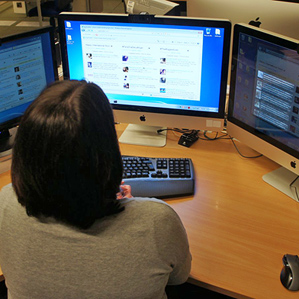Software Makes Multiple Screens Less Distracting
Most computer interfaces are designed to capture your attention—whether you like it or not. A new system for computers with multiple screens, called Diff Displays, responds to inattention by making the information on the screen a user isn’t focused on less distracting.

Created by human-computer interaction researchers at the University of St. Andrews, Diff Displays uses eye-tracking software to sense when the user is no longer paying attention to a particular screen. It then replaces the content on that with a subtle visualization that reduces clutter and only highlights the most important new information.
Diff Displays was inspired by the proliferation of multiscreen displays at computer workstations, and the “increased attentional demand” that such multitasking visual environments place on users, says Per Ola Kristensson, a lecturer at St. Andrews and one of the system’s creators. “It’s impossible to attend to all of these displays at the same time,” he says. “How can we create subtle, nondistracting visualizations that support this inattention instead?”
To create Diff Displays, Kristensson and his colleagues, Aaron Quigley, a professor, and Jakub Dostal, a PhD student, mounted webcams on top of each display in a three-screen workstation and installed eye-tracking software to detect when the user directs his or her gaze at a particular display. (The software, says Kristensson, is 98 percent accurate at detecting gazes directed at additional displays situated 40 to 60 degrees off the main-screen axis. It disregards false-positives from gazes detected in the background, such that of a coworker walking by.)
The screen that the user is focusing on behaves normally. But when Diff Displays detects that the user has shifted attention away, it inserts an interactive overlay that dims the content’s brightness and replaces its colors with different shades of gray.
The overlay also includes one of four visualizations designed to highlight important information: “Freeze Frame,” a static snapshot of the screen’s state when attention was directed elsewhere; “Pixmap,” which highlights any real-time pixel changes with normal brightness (“In your Twitter feed, you’d see bright pixels around new tweets,” Kristensson says); “Windowmap,” similar to Pixmap but on the window scale (i.e., any window with active content will rebrighten); and “Aura,” which draws a subtly pulsating outline within any newly active window content. When the user redirects attention back to a screen, the overlay quickly fades away, providing a visual distinction which directs the user’s attention to the new information.
User testing showed that the “Pixmap” visualization offered the best trade-off between information density and intrusiveness, Kristensson says, but “all of the visualizations reduced the number of times that a user switched attention between displays by about half.” Diff Displays’ visualizations make the user less worried about missing something on a screen they’re not paying active attention to, Kristensson says; therefore, they feel less pressure to frequently “context-switch” between screens. “You can rest assured that when you look back, it’ll tell you what matters,” he says.
This kind of “inattention-friendly” display could be particularly useful to specialized workers like air-traffic controllers and financial analysts, says Shamsi Iqbal, who studies multitasking and interface design at Microsoft Research. “These jobs require you to maintain constant awareness of many things at once, where information is changing all the time,” she says. “Showing what the changes were where you last left off is especially helpful.”
Kristensson agrees, but says Diff Displays was designed for typical knowledge workers. “What motivated us is that lots of everyday people have multiple displays now,” he says. “It’s a good sign that the technology can be applied to many areas. I’m planning to use it myself.” Diff Display was presented at the ACM International Conference on Intelligent User Interfaces in Santa Monica, California, last week, and is available as a free download here (Windows only).
Keep Reading
Most Popular
Large language models can do jaw-dropping things. But nobody knows exactly why.
And that's a problem. Figuring it out is one of the biggest scientific puzzles of our time and a crucial step towards controlling more powerful future models.
How scientists traced a mysterious covid case back to six toilets
When wastewater surveillance turns into a hunt for a single infected individual, the ethics get tricky.
The problem with plug-in hybrids? Their drivers.
Plug-in hybrids are often sold as a transition to EVs, but new data from Europe shows we’re still underestimating the emissions they produce.
Stay connected
Get the latest updates from
MIT Technology Review
Discover special offers, top stories, upcoming events, and more.